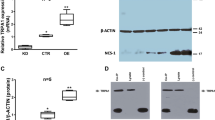Abstract
HERG CCardiac, a C-terminal splice variant of the human ether-à-go-go-related gene (HERG A), was identified and found to be 100% homologous to HERGUSO. Real-time polymerase chain reaction data indicated that in the human heart HERG CCardiac mRNA was expressed eight times more than HERG A, whereas in human ventricular tissue it was expressed six times more than HERG A. A HERG CCardiac-green fluorescence protein (GFP) construct was heterologously expressed in Xenopus oocytes. Confocal micrographs revealed that HERG CCardiac was mainly expressed in the plasma membrane. HERG CCardiac channel expressed in oocytes produced slower inactivating outward currents and faster deactivating tail currents than those of HERG A channel. Equal amounts of HERG A and HERG CCardiac cRNA coinjected into oocytes formed intermediate HERG A + HERG CCardiac heteromultimers, which was reconfirmed by immunoprecipitation experiments with a HERG A N-terminal antibody. These heteromultimers had different inactivation, deactivation and activation kinetics from those of HERG A and HERG CCardiac channels. HERG A + HERG CCardiac heteromultimers significantly reduced the model action potential mean amplitude and increased the fast and slow inactivation τ values of the action potential repolarization phase, suggesting involvement of HERG A and HERG CCardiac heteromultimers in modulation of the refractory interval.








Similar content being viewed by others
References
Aydar E., Palmer C. 2001. Functional characterization of the C-terminus of the human ether-a-go-go-related gene K+ channel (HERG). J. Physiol. 534:1–14
Barhanin J., Lesage F., Guillemare E., Fink M., Lazdunski M., Romey G. 1996. K(V)LQT1 and lsK (minK) proteins associate to form the IKs cardiac potassium current. Nature 384:78–80
Curran M.E., Splawski I., Timothy K.W., Vincent G.M., Green E.D., Keating M.T. 1995. A molecular basis for cardiac arrhythmia: HERG mutations cause long QT syndrome. Cell 80:795–803
Farrelly A.M., Ro S., Callaghan B.P., Khoyi M.A., Fleming N., Horowitz B., Sanders K.M., Keef K.D. 2003. Expression and function of KCNH2 (HERG) in the human jejunum. Am. J. Physiol. 284:G883–G895
Jones E.M., Roti Roti E.C., Wang J., Delfosse S.A., Robertson G.A. 2004. Cardiac IKr channels minimally comprise hERG 1a and 1b subunits. J. Biol. Chem. 279:44690–44694
Kupershmidt S., Snyders D.J., Raes A., Roden D.M. 1998. A K+ channel splice variant common in human heart lacks a C-terminal domain required for expression of rapidly activating delayed rectifier current. J. Biol. Chem 273:27231–27235
Kupershmidt S., Yang T., Chanthaphaychith S., Wang Z., Towbin J.A., Roden D.M. 2002. Defective human ether-a-go-go-related gene trafficking linked to an endoplasmic reticulum retention signal in the C terminus. J. Biol. Chem. 277:27442–27448
London B., Aydar E., Lewarchik C.M., Seibel J.S., January C.T., Robertson G.A. 1998. N- and C-terminal isoforms of HERG in the human heart. Biophys. J. 74:A26
London B., Trudeau M.C., Newton K.P., Beyer A.K., Copeland N.G., Gilbert D.J., Jenkins N.A., Satler C.A., Robertson G. A. 1997. Two isoforms of the mouse ether-a-go-go-related gene coassemble to form channels with properties similar to the rapidly activating component of the cardiac delayed rectifier K+ current. Circ. Res. 81:870–878
McDonald T.V., Yu Z., Ming Z., Palma E., Meyers M.B., Wang K.W., Goldstein S.A., Fishman G.I. 1997. A minK-HERG complex regulates the cardiac potassium current IKr. Nature 388:289–292
Mitcheson J.S., Sanguinetti M.C. 1999. Biophysical properties and molecular basis of cardiac rapid and slow delayed rectifier potassium channels. Cell. Physiol. Biochem. 9:201–216
Nerbonne J.M. 2000. Molecular basis of functional voltage-gated K+ channel diversity in the mammalian myocardium. J. Physiol. 525:285–298
Pajor A.M., Hirayama B.A., Wright E.M. 1992. Molecular biology approaches to comparative study of Na+-glucose cotransport. Am. J. Physiol. 263:R489–R495
Pfaffl M.W. 2001. A new mathematical model for relative quantification in real-time RT PCR. Nucleic Acids Res. 29:e45
Pond A.L., Nerbonne J.M. 2001. ERG proteins and functional cardiac IKr channels in rat, mouse, and human heart. Trends Cardiovasc. Med. 11:286–294
Sanguinetti M.C., Jiang C., Curran M.E., Keating M.T. 1995. A mechanistic link between an inherited and an acquired cardiac arrhythmia: HERG encodes the IKr potassium channel. Cell 81:299–307
Sanguinetti M.C., Jurkiewicz N.K. 1990. Two components of cardiac delayed rectifier K+ current. J. Gen. Physiol. 96:195–215
Shoeb F., Malykhina A.P., Akbarali H. I. 2003. Cloning and functional characterization of the smooth muscle ether-a-go-go-related gene K+ channel. J. Biol. Chem. 278:2503–2514
Trudeau M.C., Warmke J.W., Ganetzky B., Robertson G. 1995. HERG, a human inward rectifier in the voltage-gated potassium channel family. Science 269:92–95
Tseng G.N. 2001. IKr: the hERG channel. J. Mol. Cell. Cardiol. 33:835–849
Warmke J.W., Ganetzky B. 1994. A family of potassium channel genes related to eag in Drosophila and mammals. Proc. Natl. Acad. Sci. USA 91:3438–3442
Yellen G., 2002 The voltage-gated potassium channels and their relatives. Nature 419:35–42
Acknowledgement
We thank Drs. J. M. Nerbonne and A. Pond for kindly providing the HERG N-terminal antibody.
Author information
Authors and Affiliations
Corresponding author
Rights and permissions
About this article
Cite this article
Aydar, E., Palmer, C. Expression and Functional Characterization of the Human Ether-à-go-go-Related Gene (HERG) K+ Channel Cardiac Splice Variant in Xenopus laevis Oocytes. J Membrane Biol 211, 115–126 (2006). https://doi.org/10.1007/s00232-006-0010-9
Received:
Revised:
Published:
Issue Date:
DOI: https://doi.org/10.1007/s00232-006-0010-9




